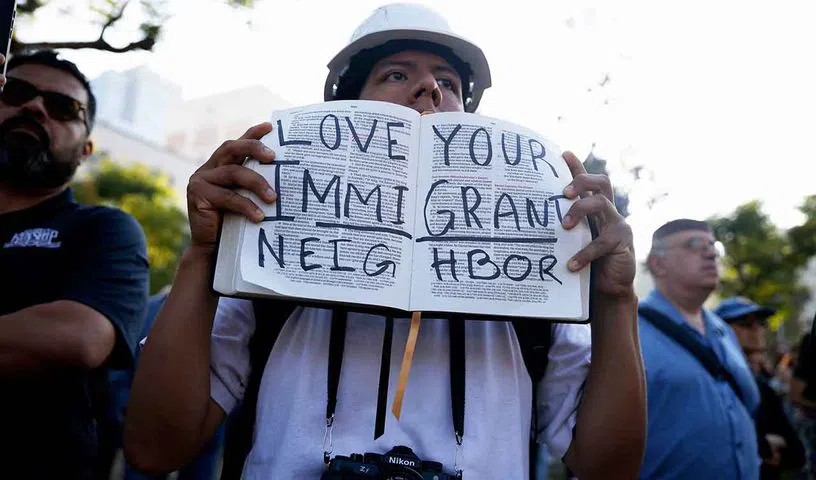Protests, National Guard deployment, and escalating tensions have spread to cities like New York, Chicago, Dallas, and Austin.
Table of Contents

Protests and Curfews Grip the Nation
The streets of Los Angeles, New York, Chicago, and beyond are pulsing with unrest. From curfews to National Guard deployments, the nation is grappling with a wave of protests sparked by President Donald Trump’s aggressive immigration crackdown. What began as targeted raids has spiraled into a broader clash of ideals, fear, and frustration. Here’s a deep dive into the escalating tensions, the human toll, and the questions hanging over America’s future.
Los Angeles Under Curfew: A City on Edge
On the first night of a curfew in downtown Los Angeles, police detained over 20 people, primarily for violating restrictions aimed at curbing vandalism and theft. The curfew, blanketing a 2.5-square-kilometer area, was a response to five days of protests that have shaken the city of 4 million. Authorities used crowd-control projectiles to disperse hundreds of demonstrators rallying against Trump’s immigration policies, though officials noted fewer clashes compared to earlier, more volatile nights.
By morning, the streets showed signs of normalcy—residents walked dogs, commuters sipped coffee—but the calm felt fragile. Los Angeles Mayor Karen Bass condemned the federal raids, accusing the White House of sowing fear rather than safety. “When you raid Home Depots and tear families apart, you’re not targeting criminals—you’re terrorizing communities,” Bass said at a press conference. Her words reflect a growing sentiment that the administration’s tactics are less about law enforcement and more about intimidation.
The Human Cost of Raids
The protests erupted after immigration authorities ramped up arrests, targeting workplaces like car washes and Home Depots. Community groups report ICE agents appearing at libraries and even near school graduations, prompting heightened security and virtual attendance options for parents. The raids have torn through communities, leaving families fractured and neighborhoods on edge. Bass highlighted the shift in rhetoric: what began as a promise to target “violent felons and gang members” has morphed into sweeping operations that ensnare everyday workers and parents.
A National Flashpoint: Protests Spread
Los Angeles is not alone. Demonstrations have flared in cities like New York, Chicago, Dallas, and Austin, each grappling with its own response to the immigration crackdown. In New York, police arrested 86 people during protests in lower Manhattan, though Commissioner Jessica Tisch emphasized that most demonstrators remained peaceful. In Chicago, a 66-year-old woman was injured after being struck by a car during a protest, a stark reminder of the risks as tensions boil over.
In Texas, Governor Greg Abbott has placed National Guard troops on standby in cities like Austin and San Antonio, where police have already used chemical irritants to disperse crowds. The deployment of military forces, including 2,000 National Guard soldiers and 700 Marines in Los Angeles alone, has raised alarms about the militarization of domestic policy. California Governor Gavin Newsom called it a “military dragnet,” accusing Trump of undermining democracy itself. Newsom’s legal challenge to halt military involvement in immigration enforcement awaits a court hearing, but for now, the operations continue.
Voices from the Ground
The protests carry a mix of anger and desperation. In Los Angeles, thousands have rallied peacefully outside City Hall, while others have blocked freeways and set cars ablaze. Two individuals face up to 10 years in prison for allegedly throwing Molotov cocktails at police, a sign of how quickly tensions can escalate. U.S. Attorney Bill Essayli warned, “If you took part in these riots and were looking to cause trouble, we will come looking for you.” Yet for many protesters, the fight is personal—a stand against policies that threaten their families, neighbors, and way of life.
Trump vs. Newsom: A War of Words
At the heart of the unrest is a bitter feud between President Trump and Governor Newsom. Trump has branded protesters “animals” and “a foreign enemy,” claiming on Truth Social that Los Angeles “would be burning to the ground” without his military intervention. Newsom, in turn, has accused Trump of launching an “assault” on democracy, warning that California is only the beginning. “Other states are next,” he said, framing the crackdown as a national threat.
The rhetoric is more than political posturing—it’s a reflection of a deeply divided nation. Trump’s supporters see the raids as a necessary step to enforce immigration laws, while critics argue they’re a deliberate tactic to instill fear in immigrant communities. The truth likely lies in the gray space between, but the consequences are undeniable: families separated, cities under curfew, and a growing sense of unease.
What’s Next for America?
As the curfew in Los Angeles stretches into its second day and protests continue nationwide, the question looms: where do we go from here? The deployment of National Guard and Marines signals a willingness to escalate, but at what cost? Schools are on high alert, businesses are bracing for more raids, and communities are caught in the crossfire of a policy battle that shows no signs of slowing.
The unrest also raises broader questions about the role of the military in domestic affairs. Newsom’s court challenge could set a precedent, but with a hearing days away, the immediate future looks tense. For now, the streets of America’s cities are a battleground—not just for policy, but for the soul of the nation.
Join the Conversation
What do you think about the protests and the immigration crackdown? Are the curfews and military presence a necessary response, or are they fanning the flames of division? Share your thoughts below, and let’s unpack this moment together.
